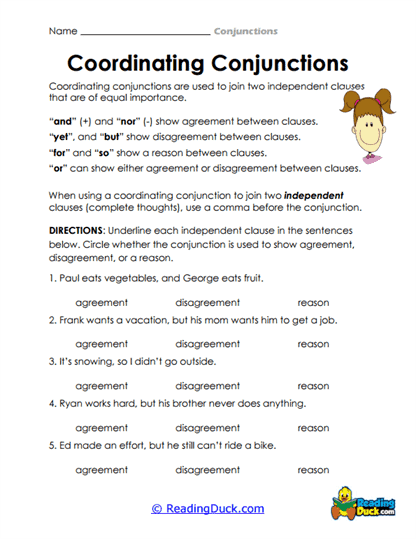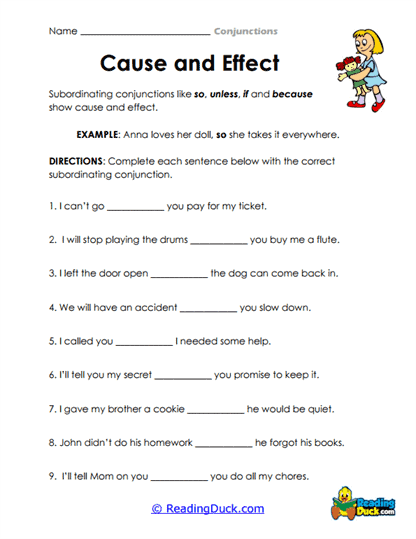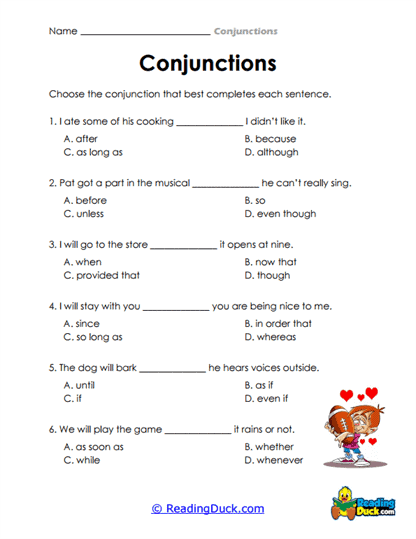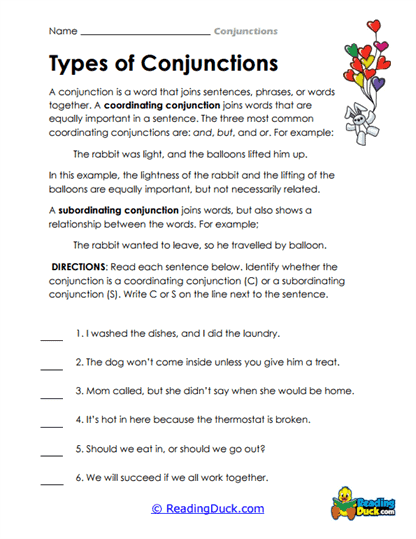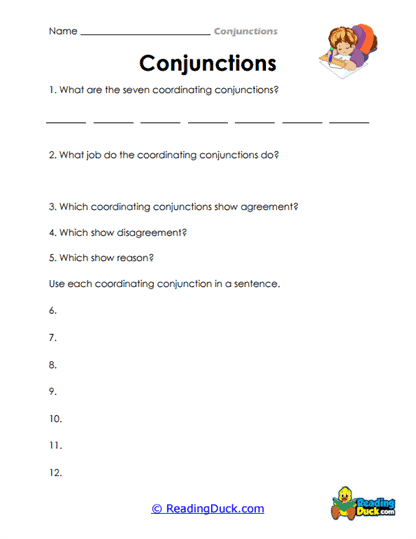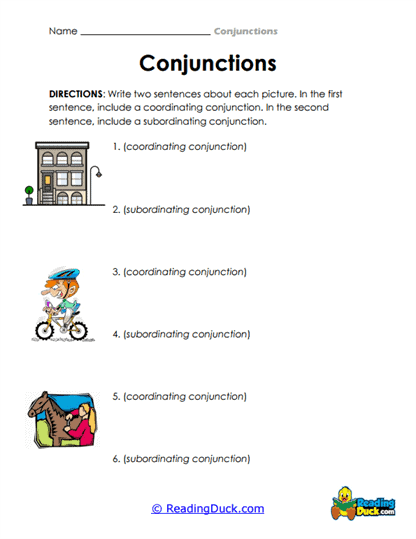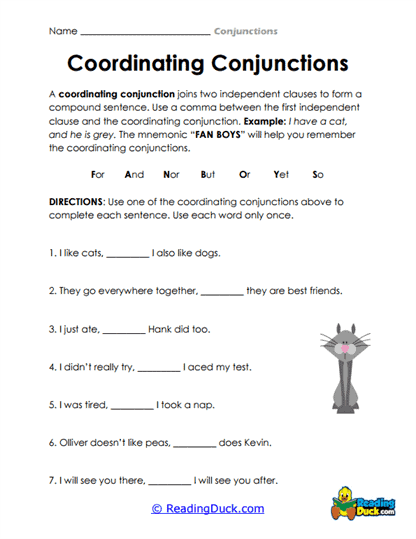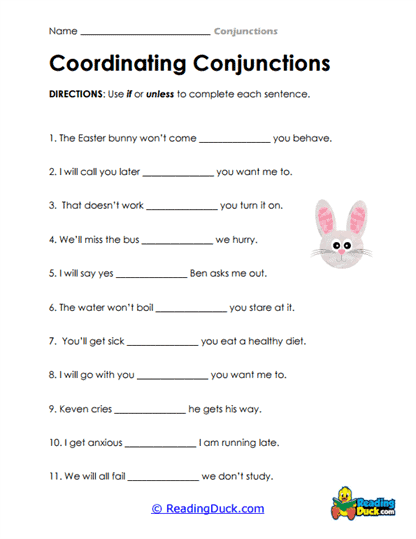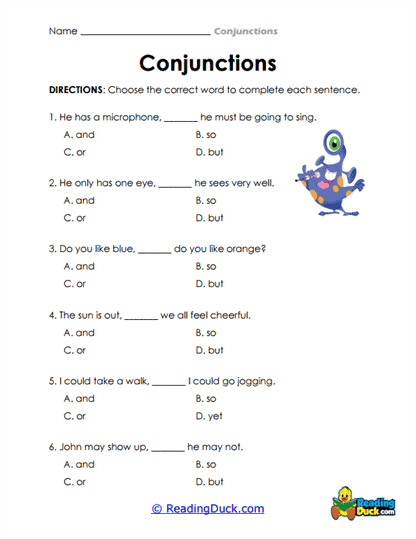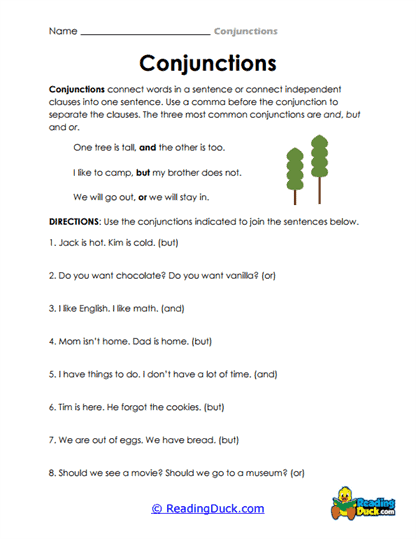Conjunctions Worksheets
About Our Conjunction Worksheets
This collection of Conjunctions Worksheets is designed to help students master a critical aspect of grammar. By focusing on the proper use of conjunctions, these worksheets enable students to craft more complex and meaningful sentences. Conjunctions play a vital role in connecting words, phrases, and clauses, allowing for a smoother flow of ideas. As part of the Grammar category in the Skills section, these worksheets equip students with essential skills that improve both written and spoken communication.
Through clear explanations, engaging exercises, and structured examples, these worksheets guide students through the various types of conjunctions—coordinating, subordinating, and correlative. The activities challenge learners to practice and apply what they learn, reinforcing their understanding and promoting long-term retention. Available in a convenient PDF format, the worksheets can be easily viewed, downloaded, and printed, providing a flexible learning experience. Each worksheet comes with a downloadable answer key, allowing students and educators to assess progress and address any misunderstandings.
Understanding Conjunctions in Depth
Conjunctions are essential connectors in language, linking different parts of a sentence to make communication more efficient and expressive. Without conjunctions, our sentences would be disjointed and repetitive, lacking the flow needed for clear and cohesive communication.
Definition of Conjunctions:
Conjunctions are words that join together words, phrases, or clauses within a sentence, helping to create more complex and nuanced expressions of thought. They serve as bridges between different parts of a sentence, allowing speakers and writers to combine ideas smoothly, avoid unnecessary repetition, and establish relationships between concepts. Without conjunctions, we would be forced to express each thought in a separate, often disconnected sentence, which would make communication cumbersome and monotonous.
The primary role of conjunctions is to clarify the logical relationship between the linked sentence elements. These relationships can express coordination (when two or more ideas are given equal importance), subordination (when one idea depends on another), or correlation (when paired elements work together in a sentence). Mastering conjunctions is crucial because they help to create a more natural, fluid communication style, which is particularly important in both written and spoken language.
By combining independent and dependent clauses, words, or phrases, conjunctions allow for the expression of cause and effect, contrast, alternatives, choices, and conditions. As students learn to use conjunctions properly, they improve their ability to articulate thoughts in a more structured and connected manner, both in everyday conversation and in more formal writing.
Types of Conjunctions:
Coordinating Conjunctions:
- These conjunctions connect words, phrases, or clauses of equal importance or structure. The most common coordinating conjunctions can be remembered with the acronym FANBOYS: for, and, nor, but, or, yet, so.
Example: "I wanted to go to the park, but it started raining."
Here, "but" connects two independent clauses that could stand alone as sentences.
Subordinating Conjunctions:
- Subordinating conjunctions join an independent clause (a complete sentence) with a dependent clause (a sentence that cannot stand on its own). These conjunctions establish a relationship of time, cause, condition, or contrast between the clauses.
- Common subordinating conjunctions include because, although, since, if, unless, while, when.
Example: "She stayed inside because it was too cold outside."
The conjunction "because" links the reason for her staying inside to the main clause.
Correlative Conjunctions:
- These conjunctions work in pairs to link balanced sentence elements. They connect equivalent structures, such as words, phrases, or clauses, and often emphasize the relationship between them.
- Some common correlative conjunction pairs are either…or, neither…nor, both…and, not only…but also.
Example: "Both the teacher and the students enjoyed the activity."
The correlative conjunction "both…and" links two subjects that equally share importance in the sentence.
Importance of Conjunctions: Conjunctions are crucial for creating complex, varied, and meaningful sentences. By understanding the proper use of conjunctions, students can avoid the overuse of simple sentences, enhancing their writing fluency and depth. Furthermore, conjunctions are key to communicating logical relationships, such as cause and effect, contrast, or sequence, which are essential in both academic and real-life contexts.
Effective Techniques for Introducing Conjunctions to Students
When teaching conjunctions, educators can adopt several strategies to ensure students understand this vital grammar component. Introducing the topic in a way that captures interest and engages critical thinking can significantly enhance students' comprehension.
- Start with Simple Examples: Begin with basic coordinating conjunctions such as and, but, and or. Present simple sentences that students already understand, and then show how conjunctions combine these sentences to make them more dynamic.
Example: "I like pizza. I like pasta." → "I like pizza and pasta."
- Use Visual Aids: Visual aids, like charts and sentence diagrams, help students grasp how conjunctions link different parts of a sentence. For example, a diagram could show how a coordinating conjunction connects two independent clauses in a sentence.
- Interactive Games: Engage students in activities that make learning conjunctions fun. Games like “Conjunction Bingo” or “Sentence Building” encourage students to apply conjunctions in a playful, competitive setting.
- Sentence Combining Activities: Have students practice combining two or more short sentences into a single sentence using the appropriate conjunction. This teaches them how conjunctions contribute to sentence variety and complexity.
Example Exercise: Combine "She is tired" and "She will finish the project" with a subordinating conjunction. Possible answer: "Although she is tired, she will finish the project."
Overcoming Common Challenges in Learning Conjunctions
Students may initially struggle with the different types of conjunctions and when to use each one correctly. These challenges can be due to a lack of understanding of sentence structures or confusion over similar conjunctions that serve different purposes.
Challenge: Distinguishing Between Conjunction Types: Students may confuse subordinating conjunctions with coordinating ones, especially when both seem to serve a linking function.
Strategy: Provide clear explanations and examples of how each conjunction type operates. For instance, show that coordinating conjunctions link elements of equal importance, while subordinating conjunctions introduce dependent clauses.
Challenge: Overusing Simple Conjunctions: Beginners may rely too much on and or but, avoiding more complex conjunctions.
Strategy: Encourage the use of varied conjunctions through exercises that specifically target less commonly used conjunctions like although, unless, and neither…nor. Introduce sentence-building activities that require students to replace simple conjunctions with more sophisticated alternatives.
Challenge: Misplacing Conjunctions in Sentences: Students often struggle with where to place conjunctions, particularly in more complex sentences with multiple clauses.
Strategy: Teach students to identify independent and dependent clauses, then practice placing conjunctions in sentence-combining activities. Using sentence diagramming can also clarify the correct placement.
Activities for Reinforcing Conjunction Skills
To solidify students' understanding of conjunctions, educators can offer a range of supplementary activities. These activities are adaptable for both classroom and homeschool settings, making them versatile tools for reinforcing learning.
- Conjunction Scavenger Hunt (Grades 3-5): Have students search through a short story or a passage for examples of conjunctions. After identifying them, students can categorize them into coordinating, subordinating, and correlative conjunctions.
- Create Your Own Story (Grades 4-6): Students write a short story using a list of conjunctions provided by the teacher. This activity encourages creativity while reinforcing the practical use of conjunctions in writing.
- Conjunction Sorting Game (Grades 2-4): Prepare a set of sentence strips and conjunctions on separate cards. Students must match the correct conjunction to complete the sentence, making it an interactive way to practice identifying and using conjunctions.
- Sentence Expansion (Grades 3-6): Provide students with short, simple sentences and ask them to expand these sentences using conjunctions. This helps students think critically about how conjunctions change the structure and meaning of a sentence.
Conjunctions as a Key Grammar Skill
Mastering conjunctions is not only vital for academic success but also has practical implications in everyday communication. Understanding how to use conjunctions properly allows students to express complex ideas clearly and logically. Whether writing essays, reports, or even engaging in daily conversations, conjunctions provide the glue that holds thoughts together, enabling effective communication.
By engaging with these Conjunctions Worksheets, students gain the tools to enhance their language skills, contributing to their overall literacy. These worksheets serve as a practical resource for building a foundation in grammar, with real-world applications in both school and life.
